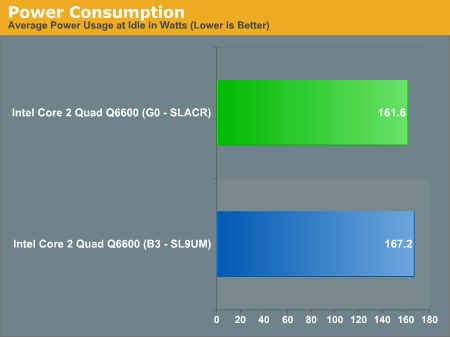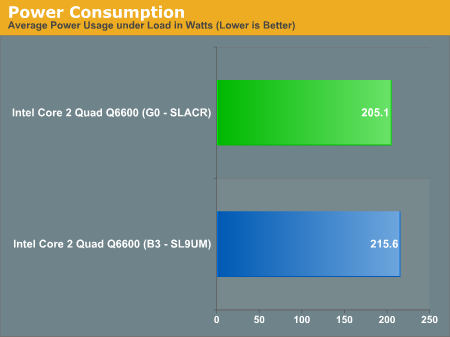Intel Core 2 Q6600 G0 Stepping: Cheap Quad Core Just Got Better
by Anand Lal Shimpi on August 16, 2007 11:53 AM EST- Posted in
- CPUs
Power Consumption: A Cooler SLACR?
We know from Intel's own documentation that G0 cores draw less power at idle than their B3 predecessors. In the C1E power state the G0 Q6600 is supposed to dissipate 24W compared to 50W of its B3 predecessor. On paper the savings are dramatic, but keep in mind that a processor doesn't spend all of its time in C1E - so how does G0 stack up in the real world?
In order to find out we looked at total system power consumption in two situations: idle and when running our Windows Media Encoder 9 test, a fairly CPU intensive benchmark. We measured average power consumption over the course of the test.

At idle, G0 draws 5.6 fewer watts, a reduction of just over 3%. Nothing terribly impressive, but let's look at results under load:

The G0 advantage grows to 10.5W under load, or an advantage of just under 5%. This alone isn't reason to upgrade, but lower power consumption is far from a bad thing. Does the new G0 stepping translate into better overclocking potential given its lower power consumption?










34 Comments
View All Comments
gigahertz20 - Thursday, August 16, 2007 - link
Anand,Your overclocking results mean nothing if you don't list what type of cooling you used? Stock Intel cooler? Tuniq Tower 120? Thermalright Ultra-120 Extreme? Typhoon VX? Zalamn? Scythe? Noctua? The only thing you said was "our max was 3.51GHz (390 x 9.0) without resorting to improved cooling" so by that statement I'm assuming you must have been using air but which HSF?
How can you miss this? Indians aren't supposed to make mistakes, just kidding :) We're all human.....at least I think :)
Anand Lal Shimpi - Thursday, August 16, 2007 - link
Sorry, I thought I mentioned that I was using the stock Intel HSF. :)Take care,
Anand
Roy2001 - Friday, August 17, 2007 - link
Could you try a better HSF? ATers whwant to OC this beast would avoid stock HSF I believe.Omega215D - Thursday, August 16, 2007 - link
He was just being a SLACR...:ducks:
vijay333 - Thursday, August 16, 2007 - link
Could you also comment on whether there were any noticeable differences between the CPUs with regards to temps? Kinda related to the wattage of course, but actual idle/load temperature values would help too. Thanks.aka1nas - Thursday, August 16, 2007 - link
I didn't see listed which board was used to test overclockability of the two chips. Lots of boards still have issues with clocking G0s to high FSB speeds, especially at a 9x multi as the previous poster mentioned.Anand Lal Shimpi - Thursday, August 16, 2007 - link
Sorry, I updated the article with the test table. I used the Gigabyte GA-P35C-DS3R.Take care,
Anand
ChronoReverse - Thursday, August 16, 2007 - link
I have two G0's and it seems there's a great deal of variation even for two CPUs in the same batch.You should check the VID (using Core Temp) of the CPU. A lower VID means Intel rated the CPU to run at stock with a lower voltage, generally meaning more overclocking headroom. Of my two G0 Q6600's, one was 1.3125V while the other was 1.2750V.
Also, the 9X multiplier is harder to overclock on than lower multipliers (for reasons unknown to me but I've encountered it myself as well as read other people commenting thus). My 1.3125V Q6600 can boot and run at 3.6GHz (450x8) almost stably (it can Prime95 all four cores for at least 20 minutes) but trying to do the same at 400x9 will always fail. I know that 400MHz FSB works since I can boot at 400x8, so I'm assuming the other factor would be the multiplier.
Dainas - Saturday, August 18, 2007 - link
Would it be possible to get a VID of 0.8250v? As that it what Core Temp reads for my G0 Q6600, but I have doubts as the the accuracy as I'm x64 Vista and Core temp cannot find the temps (the rest of the read stats check out though).Also CPU-z reads its default Voltage as being around 1.18v.
Darkmatterx76 - Thursday, August 16, 2007 - link
Since OC potential varies so much with these CPU's are there any companies that test the CPU's they buy from Intel/AMD and sort them based on the OC potential they have? Memory companies often test and sort their memory and package them according to their quality. It would be nice to get a CPU that's been tested for better then average OC potential without having to pay $1000 for an Extreme brand CPU. I wouldn't mind paying a little bit more for a Q6600 that I knew had some good OC room.